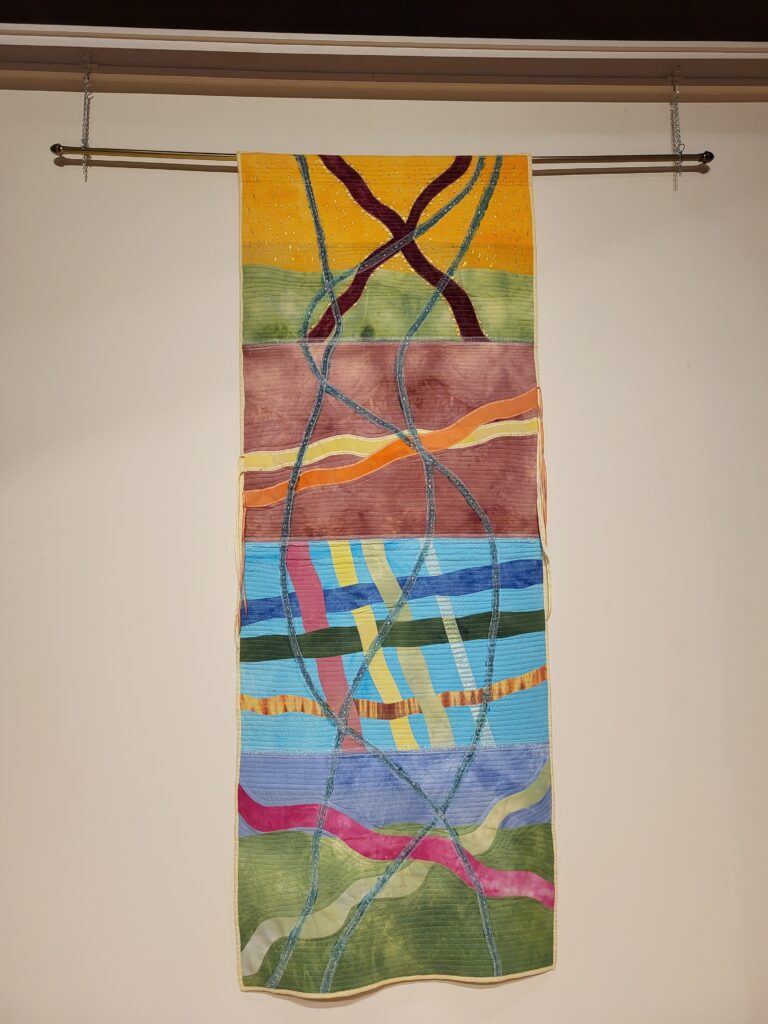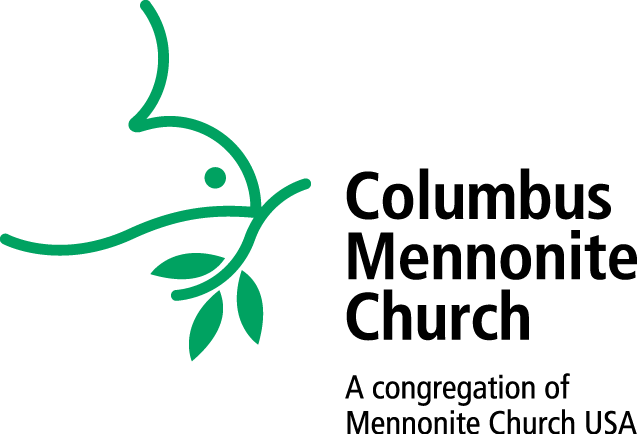Text: Luke 7:1-19
Speaker: Joel Miller
Interwoven.
Our banner for this month doesn’t have a name, but if it did, Interwoven would be a good one. It was made for a different occasion by Connie B from Cincinnati Mennonite Fellowship. We get to repurpose it for this series.

The bottom panel shows two lines on a green and blue background, two intersecting lives within creation. The next panel multiplies those lines. It’s the interweaving of family, neighbors, community. The third panel up shows lives so tightly interwoven they merge for a time. In the top panel the green shows up again, then the golden sky, two lines now more vertical, reaching up to the heavens in a kind of mutual holy longing. All of this is connected with three interwoven threads – a Trinity bottom to top, top to bottom, ever present throughout. Even God is interwoven within Godself.
This four week series is all about the interweaving of lives and communities and histories and God.
The story of the healing of the centurion’s slave in Luke chapter 7 shows just how complicated this interweaving can be. Consider the people involved. There is the centurion who, as the title suggests, had charge of 100 soldiers. These were Roman soldiers, the colonizing and occupying forces of the 1st century Mediterranean world. There is the sick man close to death, who some translations call a servant and others a slave of the centurion. There are the Jewish town elders who, perhaps surprisingly, advocate for the centurion who wishes that his slave be healed. They say: “This centurioun, he is worthy.” “He loves our people.” “It is he who built the synagogue for us.” There are the “friends,” other brokers sent by the centurion. And there is Jesus, the indigenous Jew. Jesus the teacher. Jesus the wandering holy man, now back in Capernaum where he stayed often. Jesus the healer.
What a collection of cloth within this tapestry that was life in first century Galilee. How many layers of history within this single panel of a story? How many degrees of social hierarchy? What sorts of daily negotiations for power and honor and survival lie just beneath the surface?
Interwoven.
Over the last number of years we’ve been trying to pay more attention to these kinds of questions. How are our lives interwoven with the land we live on and the histories of this place? Where are we in the current tapestry, and where have we been? The words of our Peace Candle are one way we keep these thoughts in front of us: “We remember that we gather on land where Miami, Shawnee, those known as the Hopewell, and other Indigenous peoples have lived and labored, fought and loved. We join our hearts with all those who yearn for peace with justice.”
Are there ways, we’ve been asking, to join a reweaving of lives and stories in a way that is healing? Healing for land and other people would be good. And healing for ourselves in ways we may not have even realize we’re unwell.
At about this time last year I found myself in a room at Sharon Woods Metro Park where that question of mending and reweaving was lingering in the air, and the dynamics felt about as complex as Luke chapter 7. There was the Director of Metro Parks, Tim. The Director of NAICCO, the Native American Indian Center of Central Ohio, Ty, and three of us from CMC. How we got there is a bit of a long story, although not too long. In short, we’ve formed a relationship with Ty and NAICCO over the last few years as part of these commitments we’re making. NAICCO has a Land Back campaign. They’re trying to purchase 20 acres, preferably within Franklin County, as a home base. Our church has been contributing toward this campaign through our Reparative Debt Payments that are part of our annual budget.
Through conversations with Ty and others the idea came up that we should at least check in with Metro Parks about working with NAICCO to secure land. Several emails later, we had a meeting with the director of Metro Parks.
Did I mention the dynamics in the room were complex? How many layers of history? What all frayed threads and possible futures when you have a Native American leader, a government employee overseeing land management and acquisition, and three white settler Mennonites?
Interwoven we were, at least for 60 minutes.
There was, thankfully, a good spirit in the room. We opened the meeting and mostly disappeared in the background. Tim and Ty were connecting about their commitment to land conservation, even looking at parcels on maps that could be possibilities for NAICCO, even connecting on some common Irish heritage, which I don’t think any of us saw coming. They agreed to visit some plots of land together, which they did later in the year.
I don’t know if this is a healing story in the making. I do know they have stayed in touch and will continue to do so this year. I remain a fan of the idea that we don’t really know how any conversations and meetings and relationships get woven together over time. But that they are being woven together in a way we can’t fully see or predict, and we can keep showing up as the little frayed strips of cloth we are, sometimes with the intention of disappearing into the background as much as possible.
The story of the healing of the centurion’s slave does end with the healing of the centurion’s slave – did see that one coming – but there are reasons to be unsatisfied with how it plays out. The more satisfying story happens just after, when Jesus learns about the recent death of a widow’s only son. A woman without a husband or son was a woman on the verge of economic ruin. In weaving her son back into her life, Jesus not only restores someone she loves, he restores her prospects for good health and security. In the crush of a patriarchal society, Jesus enables a destitute woman to thrive.
But what is Jesus doing in this first story? He praises the faith of a Roman centurion. He listens to the elders for once. He restores a slave back to health, but mentions nothing of his liberation from enslavement. He doesn’t demand the centurion stop centurioning and oppressing Jesus’ people.
If you’re an egalitarian-minded, justice-oriented person, you have good reasons to be dissatisfied.
What I appreciate about this story is the same thing I find a bit disorienting. It’s a gift, perhaps especially for those of us committed to justice, and committed to taking a hard look at our own histories, as this worship series is encouraging us to do.
There is no doubt that structural injustice exists in our time and in Jesus’ time, although they wouldn’t have thought of it that way. There are laws, and hierarchies and treaties and broken treaties that benefit some and harm others. The game is rigged and many of us in this room are on the plus side of that imbalance. And that’s something for all of us to come to terms with. But what this Luke 7 story doesn’t do is divide people so easily on a plus and minus side, the privileged and the underserved, the oppressors and the oppressed.
There’s a centurion working for Rome but also committing personal wealth toward the building of a synagogue in Capernaum. There are elders who do tend to be staunch defenders of the status quo but whose underlying concern is the survival of their people and traditions through centuries of foreign rule. They are grateful for this synagogue where their people can study and learn Torah and pray, people including Jesus. The slave was beholden to his superior, but could have had great responsibility and even wealth and even privilege within the household as many slaves in the ancient world did. From his perspective, he almost certainly preferred to be healthy than deathly sick. And Jesus proclaimed good news to the poor, but he also had a thing for befriending folks like the tax collectors whose jobs kept people poor. He would visit their homes. He would sit with them, share meals. He would befriend them, actually befriend them.
All these lives are woven together in this world that we read about in our Bibles which can feel so distant at times but is, with just a bit of exploration, more familiar than we care to admit. All these lives and histories and hierarchies are woven together, with daily negotiations for power and honor and dignity and survival.
It is within this complicated weave of mutual holy longing, that Jesus weaves his own presence which at times healed the sick and defended the widow, and at times awed the crowds and at times disturbed the powerful and at times confounded even his closest friends.
So in this story, Jesus heals the centurion’s slave with no strings attached. He’s healed. That’s the end of the story as we have it, but it wasn’t the end of the story for the people involved. I’m thinking about the way people and relationships and meetings and conversations get woven together in ways we can’t see or predict.
When one weave is healed, what follows?
And I’m thinking about us. I’m thinking about how we relate with our histories, especially the parts where we look more like Roman centurions and tax collectors than poor widows or slaves. And I wonder if we can imagine Jesus befriending us, weaving himself right through us no matter where we and our ancestors fall on the continuum of oppressor or oppressed. I’m wondering what it would be like to befriend our own stories in the same way. To visit them. To sit with them. To befriend them.
We remember that we gather on land where others have lived. Land taken by violence and broken promises. We join our hearts in a holy longing for peace with justice. We allow our lives and stories and hearts to be joined and woven into something we can’t yet see.
